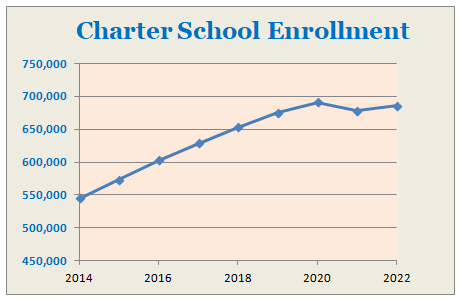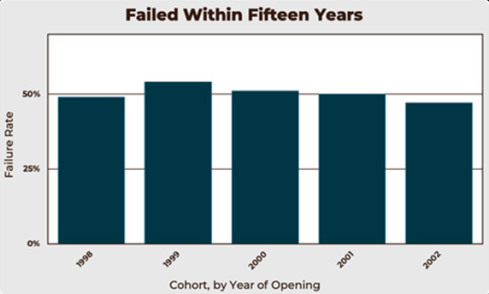By Thomas Ultican 2/29/2024
In California, from 2021 to 2023, 31 new charter schools opened but 63 closed. Since inception in 1994, charter school enrollment grew ever year until 2021. For the first time, charter school enrollment fell. This December, KIPP SoCal announced they were closing three of their 23 Los Angeles County schools. Alliance for College-Ready Public Schools and Green Dot Public Schools have also closed LA area schools.
The charter industry is struggling…
California State Enrollment Data
Los Angeles Unified School District
Los Angeles Unified School District (LAUSD) charter petitions used to arrive by the dozens but there were none this year. The 74 reported:
“Enrollment in the schools peaked in 2021, when the city’s charters enrolled nearly 168,000 students. Since then admissions have declined by nearly 11%, although not as fast as district schools.”
The “although not as fast as district schools” remark is disingenuous. In 2016, LAUSD enrollment was 639,337 and by 2023, had fallen to 538,295. This was a drop of almost 16% but over a much longer time period.
Since 2019, student enrollment in California declined by 5% and in Los Angeles County, the drop was 8.5% (California Data).
Howard Blum, reporting for the LA Times, stated:
“Twenty years ago, L.A. Unified had close to 740,000 students and was building schools as fast as it could. District-operated schools currently enroll about 420,000 students — a decline caused by reduced immigration, families moving out of L.A., lower birthrates — and, until recently, the growth of charter schools.”
Carol Burris and Network for Public Education (NPE) published Broken Promises in 2020. A stunning find was that almost 50% of charter schools had closed their doors within the first 15 years of operation (Broken Page 19).
About 50% of Charter Schools Closures by Year 15
Parents, sold a story about superior charter schools, often end up dismayed. A typical response to the closing of KIPP Poder comes from parent Gina Alonzo:
“I was very angry — very, very upset — disappointed, because we didn’t get a warning. We didn’t get a notification of what was going on — the issues that they were having.”
“We were grown as a community here. Everybody knows each other. This is all my son knows. So I’m upset and I’m thinking about the trauma that this is going to cause him.”
Besides new state policies and falling student populations, people in the choice community see the LAUSD board as hostile to charter schools. In 2022, Rocio Rivas won the district-2 seat in a tightly fought battle, not called until two weeks after the election. With a pro-public school board member, replacing termed-out Monica Garcia, the board shifted away from school choice.
In 2017, billionaires (Hastings, Broad, Rock, Fisher and, multiple Waltons) poured huge dollars into the LAUSD election, outspending their opponents 2 to 1 in America’s most expensive school board election ever. They spent more than $6 million in just the 2020 district-7 race to maintain control of the board. The 2022 results flipped the script and billionaires lost control.
John Angeli is executive director of the Los Angeles Coalition for Excellent Public Schools, a group that represents some of the city’s largest charter operators. He points out that in 2024, two incumbent school board members are running for reelection with two retiring board members, leaving open seats. Angeli believes the board could tip back to his favor in November.
School Choice – A Bad Choice
Some charter schools are abominations but most of them are reasonable. Like public schools, they are staffed with excellent or mostly decent teachers and a few who should not be in the profession. Their standardized testing results are similar to those of public schools with two deficiencies. They are likely to close their doors anytime while a public school never closes mid-school year, with no notice. Also public schools unify communities while charter schools divide them.
Birthed in the bowels of the 1950’s segregationist south, school choice has never been about improving education. It is founded on white supremacy, profiting off taxpayers, cutting taxes, selling market based solutions and financing religion. School choice ideology has a long dark history of dealing significant harm to public education.
Steve Suitts’ book, Overturning Brown, provides overwhelming evidence for the segregationist legacy of “school choice.” “Brown v Board” has been effectively gutted with “choice” as the white supremacists’ most potent strategy. In the 21st century, choice is being wielded to maintain segregation and destroy separation of church and state.
Southern segregationists often condemned “integration as the work of communists” (Suitts 32). Adopting the language of University of Chicago libertarian economist, Milton Friedman, they began denouncing the “monopoly of government schools”, calling it “socialism in its purest form” (Suitts 59). This is the basis of so-called school choice.
A Brookings Institute study of segregation in schools reported:
“Charter schools are more segregated than TPS [traditional public school] at national, state, and metro levels. Black students in charter schools are far more likely than their traditional public school counterparts to be educated in intensely segregated settings. At the national level, 70 percent of black charter school students attend intensely segregated minority charter schools (which enroll 90-100 percent of students from under-represented minority backgrounds), or twice as many as the share of intensely segregated black students in traditional public schools”.
This is a big problem concerning all races. Professors Linda R. Tropp and Suchi Saxena along with many other sociologists and educators have conducted research identifying the clear benefit of and need for school integration. They state, “New social science research demonstrates the importance of fostering sustained interracial contact between youth in order to prepare them to thrive in a multiracial society”.
UCLA Professor Gary Orfield coined the phrase “apartheid schools” for schools with a White student enrollment of 1% or less. A personal 2019 study of Washington DC charter schools revealed that 64 of the 116 charter schools could be classified as “apartheid schools”.
Yesterday, Peter Greene posted an insightful article about the coalition-promoting school choice and their splintering. One of the points he made was:
“But what the alliance didn’t produce was results. Choice did not provide a sudden lifting of all boats, despite some data-torturing attempts to show otherwise. Data-driven instruction didn’t improve the data generated by either students or teachers. Underserved communities that were supposed to be rescued from failing schools by charters and choice too often had education policies done to them rather than with them. And then there was the gross miscalculation that was Common Core, which drew attack from all across the political spectrum”.
For the Catholic Church and Evangelical Christians, like Betsy DeVos, publicly provided vouchers for private religious schools open a path to taxpayer support for their organizations. It is lamentable for their cause that every recent large scale study of vouchers showed students perform worse when transferred to voucher schools.
What is the main motive behind mega-rich spending to undermine public education? Professor Maurice Cunningham of the University of Massachusetts claimed they really want “lower state and local taxes.”
John Arnold is the billionaire Enron trader who did not go to prison when that company collapsed. He has joined forces with the billionaire CEO of Netflix, Reed Hastings, to sell the nation on the portfolio model of school management. To achieve their goal, they created The City Fund. After its founding in 2018, billionaires Bill Gates, Michael Dell and Steve Ballmer all made significant contributions.
In brief, the portfolio model directs closing schools that score in the bottom 5% on standardized testing and reopening them as charter schools or Innovation schools. In either case, they will no longer come under the purview of an elected school board. It is a march to oblivion for public schools because there will always be a bottom 5%.
Two central ideologies behind school choice are markets always make superior decisions and the cost of local control of schools is poor outcomes. Both ideas are demonstrably untrue but big money and power politics keep them alive.
It is good for America that charter schools are starting to struggle but it is heartbreaking for parents, hornswaggled by billionaires. Americans have always had school choice. If taxpayer funded public school are not wanted, there are always private schools, without the choice encumbering taxpayers.
Let’s join with the Network for Public Education and thoughtfully role back choice schools and put them under democratic control.
Stop fleecing taxpayers to finance privatized schools.


